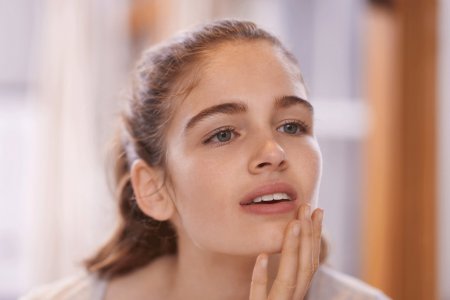Daily advices

Does your teen have trouble with oily acne-prone skin?
It’s normal.
Skin that is soft and perfectly smooth like a baby’s is no more… With the arrival of puberty, your teen’s skin changes and she finds herself dealing with oily skin problems: shine, dilated pores, a dull complexion, blackheads and spots. Most adolescents – boys and girls – are affected and the changes are perfectly normal.

What is causing your teen’s oily acne-prone skin?
The skin’s ecosystem is fragile and can be destabilised by a variety of environmental factors. In the skin ecosystem, sebaceous glands are responsible for producing sebum. How they work depends on
- Internal factors such as hormones (stress, puberty, pregnancy…)
- External factors such as UV rays, pollution, diet…
During adolescence, sebaceous glands are out of balance: they secrete too much sebum that is also poor in quality and creates irritation. This is known as dyssebohrrea.
A vicious circle forms. Too much thick sebum creates completely unbalanced skin, where bacteria are only too happy. As they arrive, pimples multiply. This is why people with oily skin also always tend to have spots.

The impact of lifestyle on oily acne-prone skin
Lifestyle can also aggravate an oily skin problem. You can help your teen develop the right habits. He might not get rid of his oily skin, but he can certainly care for it!

Diet and oily skin
Be careful with junk food, sweet foods (sweets, cookies and cakes, soft drinks…) and dairy products – except for cheese. They can all stimulate more sebum. For an acne diet, fresh fruits and vegetables, fish, poultry, soya and certain grains, which are a good source of vitamin B6, are all useful in regulating sebum.

Pollution and sebum
Pollution may also play a role in sebum’s composition by creating an imbalance between good and bad bacteria that live on the skin’s surface. A simple cleansing with Sebium H2O eliminates 93% of microparticles coming from pollution*.
*Dermscan study on 33 subjects, 2015

Sun and oily skin problems
Staying out in the sun tends to dry oily skin out, but it doesn’t last! Sebum secretion continues, sometimes at higher rates thanks to the heat. The skin also grows thicker, and prevents sebum from evacuating properly – which is why adolescents often see pimples sprout after the holidays.

Sports and oily skin
Perspiration mixed with sebum is never a pretty sight. But a quick cleansing using Sebium H2O micellar water or Sebium Foaming Gel after a workout washes it all away. Perspiration makes it possible to naturally eliminate impurities through the skin. All activities that work up a sweat boost the skin’s natural cleansing through the pores and activate microcirculation.

Stress and oily skin
We know today that stress also affects sebum production, which can get carried away. All activities that encourage relaxing are also good for skin: yoga, breathing, meditation, sophrology or sports… And minimum eight hours of sleep every night will keep skin healthy and the complexion bright!
3 key points to remember:
- Your teen may have oily skin without having blemishes. Their skin may simply be shiny and have dilated pores and blackheads…
- They may also have blemishes and not have oily skin all over their face: in this case, they have combination skin, with areas that are oily and others that are dry.
- By adopting good hygiene and care to act on oily skin, the risk of blemishes almost dries up!